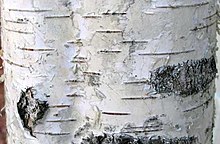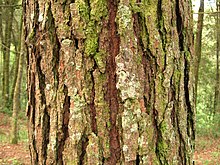Lenticel
In botany, a loosely-packed mass of often more or less rounded cork cells occurring especially in the young stem, bark or even leaf of a plant, visible on the surface as a raised, often powdery-appearing spot, through which gaseous exchange occurs
(Redirected from Lenticels)
A lenticel is porous tissue in the bark of trees. Its cells make large intercellular spaces in the periderm of the bark. They are found in the woody stems and roots of dicotyledonous flowering plants.[2]


Lenticels are also found in other woody plants, starting in the Carboniferous period. The development and increase in these primitive lenticels gave a system for aeration and gas exchange in these plants.[3]
Lenticels work as pores for the direct exchange of gases. Otherwise the bark is impermeable to gases. The name 'lenticel' comes from its lenticular (lens-like) shape.[4] The shape of lenticels is one of the characteristics used for tree identification.[5]
References
change- ↑ "Lenticel". The American Heritage Science Dictionary, Houghton Mifflin Company, via dictionary.com. Retrieved on 2007-10-11
- ↑ Gibson, Arthur C. "Bark Features in General Botany". Archived from the original on 2013-11-17. Retrieved 2012-08-19.
- ↑ Hook, Donald D. (December 1972). "Aeration in Trees". Botanical Gazette. 133 (4): 443–454. doi:10.1086/336669. JSTOR 2474119. S2CID 83842497.
- ↑ Esau, K. (1953), Plant Anatomy, John Wiley & Sons Inc. New York, Chapman & Hall Ltd. London
- ↑ Michael G. Andreu; Erin M. Givens; Melissa H. Friedman what the. "How to Identify a Tree". University of Florida IFAS extension. Archived from the original on 2013-05-14. Retrieved 2013-03-07.